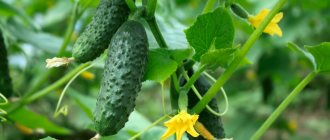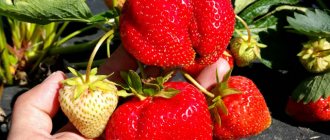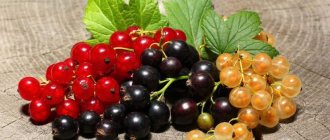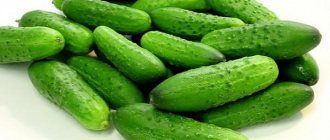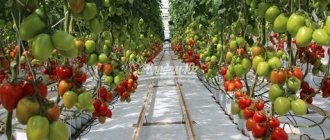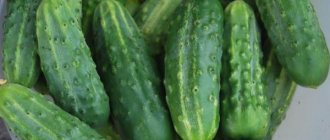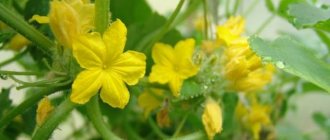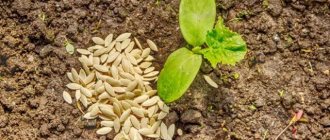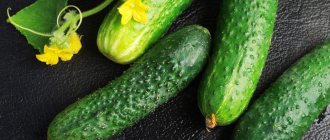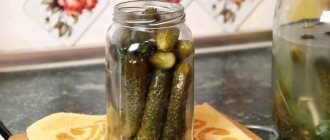Alhambra cucumber variety
A very early variety with a technical ripening period of 40-45 days. A characteristic advantage of this species is its stable immunity to garden diseases such as powdery mildew, cucumber mosaic virus, cladosporiosis and root rot. The plant has long vines with medium-sized rounded light green leaves. 2-3 ovaries are formed in each node. The flowers are self-pollinating, yellowish-white. Cucumbers are elongated, 8-12 cm long and weighing 70-110 g, dark green. The surface of the fruit is covered with large tubercles. The pulp is creamy-white, crispy, juicy, and not prone to bitterness under any growing conditions. They are sown in open ground in early May, or for seedlings in early April. Seedlings are ready for planting after 2-3 adult leaves appear. Growing in greenhouse conditions using the vertical method gives a much larger yield and a longer fruiting period. A prerequisite for proper care is daily watering with warm water. It is eaten fresh, pickled or canned.
Greenhouse varieties
Cucumber variety Murashka F1
This is one of the most versatile varieties - the plants will feel good both in greenhouse conditions and in open ground, they can even be grown on the balcony. Cucumbers do not require pollination, the fruits retain their freshness for a long time, they do not develop bitterness, and the yield is always consistently high. It appears already 40 days after planting the seeds. The sizes are average, there are not too many branches, however, if there are any, then all will be determinate with a predominance of female flowers.
There are many leaves, they are small, smooth to the touch, there are almost no empty flowers. Fruiting is long, the plants are resistant to the most common diseases - powdery mildew and cladosporiosis, but timely care should be taken to prevent diseases such as root rot and downy mildew. The size of the fruits is average - they rarely grow more than 12 cm in length, but they can be collected when they are at least 8 cm. The average weight is about 100 grams. The shape is cylindrical, there are few thorns, but they are very prickly. Cucumbers are universal - suitable for both eating and pickling.
More: TOP 10 best phytolamps for seedlings and plants
Advantages:
- Versatility both in terms of cultivation and use;
- High yield;
- Long fruiting period.
Flaws:
- It does not resist all diseases of cucumbers.
Cucumber variety Murashka F1
Cucumber variety Boy with a Thumb F1
It is an early ripening variety that will produce a harvest approximately 35-40 days after sowing. It belongs to the hybrid group and does well in tunnels, spring greenhouses and open ground. The length of the fruit is about 9-12 cm, there are small tubercles on the surface, the weight reaches 70-80 grams. The pulp is aromatic, even overripe cucumbers do not develop voids or bitterness. The seeds are small, almost invisible. The fruits have excellent taste characteristics - they can be used fresh as food, as well as for preservation.
This variety gives optimal yield when grown without seedlings. It is recommended to soak them for several hours before planting them in the soil. Before planting, the seeds are carefully inspected, making sure that they are full-bodied and approximately the same size. If this condition is met, it will be possible to achieve almost 100% germination. Plants should be fed not with chemicals, but with various natural means - droppings, slurry, ash, husks, and so on.
Advantages:
- Very tasty fruits;
- High yield;
- Long fruiting period;
- Ideally resists various diseases.
Flaws:
- Barren flowers are found, especially on branches from the main stem.
Cucumber variety Boy with a Thumb F1
Cucumber variety Benefit F1
This hybrid variety can also be classified as a high-yielding variety; moreover, such cucumbers require virtually no care. It is classified as a mid-early variety, it takes about 50 days from germination to ripening, it is self-pollinating, the flowers are in most cases female, there are practically no barren flowers, fruits are set in bunches of 3-6 pieces. You can remove about 7-8 kg of cucumbers from one bush. In terms of growth conditions, the crop is universal - it can grow in a garden bed, in a greenhouse or in a hotbed; cucumbers can be eaten fresh; they are suitable for any preparation.
It is worth noting that the vine grows quite long, so it will have to be shaped as it grows, especially if it grows on a vertical trellis. The weight of the fruit is about 100 grams with a length of no more than 13 cm. The shape is oblong, there are short stripes on the skin. The taste of cucumbers is pleasant, there is no bitterness. The pulp is quite dense, the fruits tolerate long-term transportation well and are well stored for a long time. Plants are resistant to diseases, lack of moisture, and low temperatures.
Advantages:
- High yield;
- Resistance to adverse weather conditions;
- Unpretentiousness in terms of care.
Flaws:
- The vine is quite long, it must be shaped, otherwise it will negatively affect the yield.
Cucumber variety Benefit F1
Cucumber variety Alekseich F1
The variety is quite popular among summer residents and farmers, largely due to its high yield and rapid ripening of fruits - no more than 45 days pass from the emergence of seedlings to the first harvest of cucumbers (sometimes less, depending on climatic and weather conditions). This hybrid is self-pollinating and feels good under an unheated film greenhouse or in open ground. The plants are not too large, there are few side shoots. It blooms in nodes, each of which produces up to 3 fruits.
The shape of cucumbers is cylindrical, elongated, the skin has green stripes of varying lengths, there are few tubercles, the length is in the range of 7-9 cm and weighs about 70 grams. The pulp is crispy, dense, without bitterness. The fruits are suitable for both fresh consumption and canning. From one square meter of crops you can harvest about 14 kg. It can be grown as seedlings; it can be planted in open ground when the soil warms up to about 15-16 degrees. It is recommended to plant no more than 5 shoots per square meter; if the cucumbers grow on trellises, then there should be even fewer of them - 3 or 4 plants per square of soil. The soil is pre-fertilized by adding leaves or sawdust before winter.
Advantages:
- Friendly formation of fruits, due to which a high yield is immediately ensured;
- Long-term fruiting;
- Resists well against any diseases.
Flaws:
- The soil must be prepared for this variety at the end of the previous season.
Cucumber variety Alekseich F1
Cucumber seeds Sankina love F1
The most productive hybrid among all the best varieties of cucumbers - fruiting begins early and continues for quite a long time. All plants are of the female flowering type and have almost no branches, which greatly facilitates their care. It blooms in nodes, and one node can contain up to 12 fruits. It is generally accepted that this variety is ideal for canning and pickling in a jar, but it is also good for food: the fruits are not bitter, have thin skin and dense, crispy flesh. There are pronounced tubercles on the surface, the length of cucumbers is within 8-11 cm, they withstand transportation well even over long distances. It resists diseases such as olive spot and common cucumber mosaic virus. Not sensitive to all types of powdery mildew, including downy mildew.
More: Top 10 Best Sweet Pepper Seeds
Experienced gardeners recommend forming plants strictly into one stem - this way they will receive a sufficient amount of sunlight, and all the necessary nutrients will arrive in the set fruits. After the first harvest is obtained, the cucumbers should be fed with products high in nitrogen. They should grow quite far from each other - up to two shoots are allowed per square meter. This variety loves abundant watering, always with warm water. The harvest should be harvested daily - if you follow these recommendations, you can achieve record yields: from one square meter you can get about 40 kg of cucumbers during the season.
Advantages:
- Very high yield;
- Disease resistance;
- Slight spreading of bushes.
Flaws:
- With proper care, they don't exist.
Cucumber seeds Sankina love F1
Aloe cucumber variety
The difference between this variety and other hybrids is its high yield. An early variety of gherkin type. The vegetative period of ripening is 40-42 days from the beginning of sprouting. The plant has a height of up to 15 cm with creeping stems. The leaves are green, round, densely covered with small spines on the inside. The flowers are medium-sized yellow, mostly female. Pollinated by bees or wind. The fruits are dark green in color, with sparse tubercles and black needles on the surface, 10-11 cm long and weighing 90-110 g. Grown in open ground and in greenhouses. Prefers sunny places and average soil moisture. It is recommended to fertilize three times per season with organic and mineral fertilizers. Intended for fresh consumption or for pickling and canning for the winter. The pulp is genetically free of bitterness, tender and very tasty. In proper conditions it can be stored for up to 10 days without losing its taste and marketability. Does not react to pathogens caused by powdery mildew or cucumber mosaic. The high density of the fruit allows it to withstand transportation without damage.
Which variety of cucumber is best for open ground?
If we talk about which variety of cucumbers is best for open ground, then the plants must meet certain requirements. Crops with early and medium ripening greens are suitable for growing vegetables in such conditions.
If you need to choose the seeds of the best varieties of cucumbers for open ground, you should pay attention to some recommendations:
- Do you need cucumbers with dense, crispy and very juicy pulp, for universal use? Buy a hybrid from the Russian originator Pogrebok F1.
- Dvoryansky F1 is suitable for growing on soils poor in nitrogen compounds.
- You can cultivate Altai greens for sale - they have practically no non-marketable fruits.
- If it is not possible to visit the dacha every day, then you should choose Advance F1 - the gherkins can be removed once a week without loss of taste.
- For those who prioritize getting the earliest possible harvest and harvesting greens until October, Orpheus F1 will be relevant.
- If you need to grow cucumbers using re-rotation technology, it is recommended to choose the Zador F1 hybrid.
- Do you like pickled gherkins? Pay attention to the parthenocarpic early ripening variety “Masha”.
- If it is important to get a large, high-quality harvest, then Rodnichok will do.
- Don't like fiddling with long canes, shaping them and bothering with trellises? Buy Hector F1 with bunched ovaries.
- A compact variety with a height of no more than 40 cm, which does not require special care and produces a friendly harvest - Malyshok.
In order not to “miss” the harvest, it is advisable to plant several types of cucumbers with different ripening periods and for specific purposes: fresh consumption and canning.
Cucumber variety Gift of Autumn
A mid-early variety that produces a harvest on the 39-41st day after seed germination. The plant has long, up to 2 m creeping stems, small leaves with jagged edges. The cucumbers are small, weighing up to 80-90 g and 10-14 cm long, dark green with brown spines and sparse tubercles on the surface. The pulp is dense, crispy, with excellent taste. Fertility is 2.2-2.7 kg per square meter. Fruiting lasts 58-60 days. Since this variety is considered a salad variety, it is best to use it fresh; when pickled, it is recommended to use it within three months. Seeds are sown in fertilized soil heated to +15 degrees in early May. Regular weeding and weed removal is necessary. During the flowering period, watering is done once every three days. During the period of fruit formation - daily. With insufficient watering, the fruits become deformed. Bitterness in cucumbers does not appear with any care. The variety is resistant to popular garden diseases and insect damage. It tolerates transportation well and has a long shelf life in a cool, dark place.
How to choose quality planting material
When choosing the best cucumber seeds, you need to focus on the following points:
- If a gardener wants cucumbers to grow from seeds again, then he should choose a variety, not a cross between it.
- In order to get a good harvest of cucumbers throughout the season, you should choose the best seeds - self-pollinating, long-term fruiting, and they will become indispensable for the garden. In this case, hybrids will be better than varieties because they are processed before planting.
- To grow cucumbers in areas where there are few insects, it is best to choose self-pollinating species.
Of course, we must remember that high-quality planting material is purchased in stores that have a certificate for the products.
Pickling cucumber variety
The variety was bred for cultivation in open ground, as it is bee-pollinated. Grows well in low light conditions. The fruit ripening period is 40-42 days after sprouting. Fertility is on average 4-5 kg per square meter. The wattles are long, creeping. Greens are dark green in color with light green stripes, black spines and small tubercles. The length of the cucumber is 9-14 cm, weight – 90-120 g. The pulp is very aromatic and tasty, without traces of bitterness. The seedling growing method gives the harvest two weeks earlier. The variety is intended for pickling and preservation for the winter, and is also very tasty in fresh salads. Proper care involves sowing families in early May in warm soil, timely removal of weeds, loosening the soil and feeding the plant with organic matter or mineral fertilizers. Watering should be done exclusively with warm water in the evening. Growing vertically greatly simplifies care and prevents premature aging of the plant. This significantly increases the period of fruiting. The fruits are kept fresh for 8 to 10 days without loss of presentation and taste.
Cucumber variety Lazurit
A self-pollinating type of cucumber that will delight you with its fruits already on the 42nd day from germination. The variety was bred in Poland and has a gherkin type. With good soil feeding, it ties 6-7 greens in knots. Cucumbers have a spiked surface of a dark green color, a length of 8-10 cm. The flesh is crisp, tasty, without bitterness. It is grown in greenhouses and on unprotected soil. Produces more fruit when grown vertically. Also, by letting the stems trail onto the net, you will prevent premature aging of the plant and extend the fruiting period. Lapis lazuli F1 needs watering with warm water every evening, regular harvesting and fertilizing the soil. It withstands long-term transportation and has a long shelf life. Universal use: fresh, pickled, canned and lightly salted it has high taste. The variety is immune to powdery and downy mildew, cucumber mosaic and root rot. Tolerates low temperatures well and does not require shelter at night. It is sown at the end of April, seedlings are planted at the end of May, taking into account 2-3 plants per square meter. The seeds do not require additional processing.
Lapis lazuli F1
Polish hybrid cucumber, belongs to the self-pollinating species. Early ripening, gherkin type. The fruits are short, rich green in color, with thorns. The pulp is sweet and crispy. Suitable for both open ground and greenhouse cultivation. Shows greater productivity with the vertical type of tying. It has a long shelf life and good presentation during long-term transportation. A universal cucumber. It tolerates adverse weather conditions well and is resistant to various diseases.
Cucumber variety Mamai
An early variety of hybrid cucumbers. The growing season is 45-49 days after seed germination. Characterized by simultaneous ripening of fruits. The flowers are female and pollinated by insects. The plant is a bush up to 15 cm high with long, up to 3 meters, creeping stems on which green, rounded leaves with a sharp end and whitish fluff grow. The cucumbers are 9-11 cm long and weigh 98-110 g, elongated, covered with brown spines and medium-sized tubercles. The fruits are very tasty in any form and can remain fresh and elastic for a long time. The pulp is crispy, juicy, sweet, not bitter. Fertility in greenhouse conditions is 10-12 kg per square meter, grown in open ground - 3.5-4 kg per square meter. To obtain an early harvest, it is recommended to grow seedlings using the vertical method. The variety has strong immunity against true and downy mildew and bacteriosis. With regular loosening of the soil, it is not susceptible to root rot diseases. Water with warm, settled water after sunset. Easily transports over long distances.
Rhodes cucumber variety
The variety is considered medium-late, with a fruit ripening period of 48-53 days. The plant is highly branched, not tall, with dense stems and dark green small leaves. The flowers are yellow, large, and female. Pollinated by bees. It is grown mainly in open soil. The cucumbers are short, cylindrical, bright green with light stripes down the middle. The peel is thin, lumpy, covered with dark needles. The average weight of one fruit is 70-97 g, length - 5-6 cm. It has excellent taste both fresh, canned and salted. Fertility is about 255-430 centners per hectare. A distinctive property is resistance to overgrowth and premature yellowing of leaves. Shows good resistance to powdery mildew and cucumber mosaic. Does not like shaded places and excessive watering. Sown in open ground in mid-May. Before sowing, it is recommended to soak the seeds overnight in cotton pads. This will speed up the germination period by several days. The seeds do not require additional processing.
Gerasim F1
This early ripening variety with female flowering is parthenocarpic (does not require pollination). The plant has a medium degree of branching and rich green leaves. The fruits are short, cylindrical, dark green in color with small stripes and spots. They have few tubercles, so not only the flesh, but also the skin has an excellent taste.
This cucumber variety has other advantages: it is resistant to cladosporiosis, root rot, powdery mildew and olive blight.
Variety Gerasim F1 is recommended for collecting pickles (every day) and gherkins (every 2 days).
| Purpose | Landing | Maturation (days) | Fruit length (cm) | Fruit weight (G) | Number of fruits per node |
| 39-41 | 10-12 | 90-120 | up to 8 | ||
Cucumber variety Suzanne
One of the most beloved new varieties. The reason for this is the very high yield. On average, one bush produces 2-3 cucumbers every day. And all thanks to the numerous ovaries that form in the nodes. There can be up to 5 of them in one node. Each stem is approximately 3 m long and has about 50 leaf nodes. That's why you get such a large number of fruits. Gherkin-type cucumbers are small, 7-9 cm long and weighing 80-90 g, rough to the touch with small brown spines. The variety is self-pollinating and can be successfully grown in greenhouses or on the balcony. The pulp is crispy, sweetish in taste, without bitterness. Seeds are sown in May to a depth of 2-3 cm. To prevent root rot and water stagnation, mulching is recommended. Periodic feeding of the plant will produce larger and denser fruits with a longer shelf life. To extend the fruiting period, it is necessary to promptly remove old leaves and wilted stems. The fruits are harvested every other day. Suzanna is not susceptible to a number of standard diseases, tolerates transportation well and has excellent taste in any form. The secret to successfully growing this variety is drip irrigation. With its help you will achieve the necessary soil moisture throughout the entire fruiting period. It’s not difficult to make, just place a half-barrel with water near each bush, and make a puncture from below with a thin needle.
Join our Facebook group
Suzanne
A popular new variety with high yields. You can remove up to 3 fruits from one bush daily. Cucumbers are of the gherkin type, growing up to 9 cm long. The skin has small spines, the flesh is sweet and crunchy. The variety is self-pollinating and suitable for greenhouse cultivation. Resistant to many diseases. It is distinguished by its durability and transportability.
In 2015, in the UK, farmer David Thomas grew a cucumber weighing 12.9 kg.
